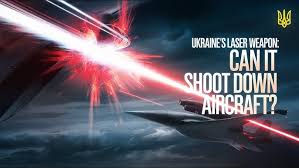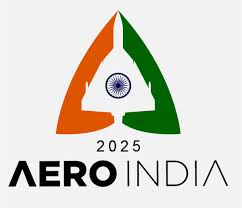Ukraine has unveiled a new laser weapon called “Tryzub” (Ukrainian for “trident”), which can shoot down aircraft over a mile away. During a defence conference, Colonel Vadym Sukharevskyi, commander of Ukraine’s Unmanned Systems Forces, announced the weapon’s capabilities. This development positions Ukraine among the few countries possessing such advanced laser technology.
The ‘Tryzub’ or Trident laser weapon that Ukraine has unveiled is a cutting-edge military system capable of shooting down aircraft and other aerial threats from over a mile away. It is a powerful laser technology designed to neutralise drones, planes, and other airborne objects by precisely disabling them at high speeds. This weapon is part of Ukraine’s efforts to enhance its defence capabilities amid ongoing conflicts.
The unveiling of the Tryzub, Ukraine’s new directed energy weapon, represents a significant leap forward in military technology. As countries worldwide increasingly turn to advanced technologies to bolster their defence capabilities, Ukraine’s Tryzub laser weapon stands out as a ground-breaking innovation.
Global Context: Nations with Laser Weapon Systems. With the Tryzub, Ukraine joins a small group of countries possessing operational laser weapons. The United States is one of the leading nations in laser technology, with its truck-mounted high-energy lasers designed to target drones, helicopters, and rockets. Similarly, countries such as China, Israel, Turkey, and Germany have also developed their laser systems. In July, South Korea announced that it would begin deploying laser systems designed to intercept drones, particularly North Korean drones, which have raised security concerns in the region. South Korea’s “Block-I” anti-air laser system, developed by Hanwha Aerospace, can engage small, low-cost drones at a fraction of traditional munitions.
Indian Effort. India is also developing laser weapons, including systems like DURGA (Directionally Unrestricted Ray Gun Array) and KALI (Kilo Ampere Linear Injector), which have been in research since the 1980s. According to reports, DURGA is designed for space-based applications, while KALI is expected to target powerful pulses of electron beams to turn off satellites.
Development Program
Origin. The Tryzub, named after the Ukrainian national emblem—a trident—was developed as part of Ukraine’s broader efforts to modernise its defence arsenal. The weapon’s development reflects a recognition of the need to keep pace with the rapid evolution of military technologies globally. The Tryzub project was initiated in response to the increased threats faced by Ukraine, particularly from the ongoing conflict with Russia and the threat of further aerial aggression.
Historical Context. Ukraine’s efforts to develop advanced defence technologies like Tryzub are rooted in its geopolitical position and the conflict with Russia that began in 2014. The annexation of Crimea and the conflict in eastern Ukraine underscored the need for a modern, effective air defence system. The Ukrainian government’s decision to invest in directed energy weapons was influenced by the success of similar systems in other conflict zones and the recognition that conventional air defence systems were becoming obsolete against evolving aerial threats.
Collaborative Development. The development of the Tryzub involved collaboration with international defence contractors and technology partners. Ukrainian defence companies, alongside foreign entities, worked on integrating advanced laser technologies into a practical military system. This collaboration sped up the development process and allowed Ukraine to leverage cutting-edge technology it might not have developed independently.
Launch and Public Demonstration. The Tryzub was officially unveiled in a public demonstration attended by military leaders, international observers, and defence experts. The event showcased the weapon’s capabilities in neutralising various targets, including drones and low-flying aircraft. The Ukrainian government positioned the Tryzub as a key component of its defence strategy, emphasising its role in protecting critical infrastructure and maintaining air superiority.
Key Features
The Tryzub laser weapon is a complex system integrating several advanced technologies to provide a robust defence solution.
Laser Technology. At its core, the Tryzub utilises high-powered laser beams capable of effectively targeting and turning off aerial threats. The weapon operates in the infrared spectrum, targeting the electronic systems of drones, planes, and other aerial objects without relying on physical munitions. This directed energy approach minimises collateral damage and the risk of unintended consequences of conventional weaponry.
Range and Engagement Capabilities. One of the most significant aspects of the Tryzub is its operational range. The weapon can engage targets from distances over two kilometers (approximately 1.24 miles), allowing it to intercept threats at a safe distance from defensive positions. The laser system is designed to automatically track and lock onto targets, adjusting the beam for movement and atmospheric conditions, thus enhancing accuracy.
Automated Tracking and Control System. The Tryzub has advanced sensors and targeting algorithms that enable automatic detection, tracking, and engagement of targets. This automation reduces the need for human intervention, allowing the system to operate independently in complex environments. Operators can manually override these systems for greater control, making them adaptable to different combat scenarios.
Energy Efficiency and Sustainability. The Tryzub’s design focuses on energy efficiency, allowing the weapon to operate for extended periods without depleting its power source. This is achieved through advancements in laser technology, including improvements in cooling systems and power management. The system can be deployed in stationary and mobile configurations, providing flexibility in how and where it is used.
Real-time Monitoring and Feedback. The Tryzub is integrated with a real-time monitoring system that provides operators with live feedback on the weapon’s performance. This system allows for continuous effectiveness evaluation, tracking the laser’s status and engagement with targets. It also facilitates rapid parameter adjustments based on the operational environment and target behaviour.
Strategic Implications
The deployment of the Tryzub laser weapon has significant strategic implications for Ukraine’s defence posture and its broader military strategy. By integrating such advanced technology, Ukraine bolsters its air defence capabilities and positions itself as a leader in modern military innovation.
Enhanced Air Defence. The Tryzub represents a revolutionary advancement in air defence technology, providing Ukraine with a robust solution to counter aerial threats. The ability to neutralise threats at a distance of over two kilometers allows for the interception of drones, helicopters, and low-flying aircraft, thus minimising risks to ground troops and infrastructure. This enhances Ukraine’s defensive posture, particularly in contested regions where air superiority is critical.
Deterrence Value. The Tryzub has a significant deterrent effect, signalling to potential adversaries that Ukraine can defend itself with cutting-edge technology. Its deployment demonstrates Ukraine’s commitment to modernising its military forces and its readiness to invest in technologies that offer a strategic advantage. This could alter future conflicts’ calculus, forcing adversaries to consider the cost and risks of engaging Ukrainian forces equipped with advanced technologies.
Adaptability in Modern Warfare. The Tryzub represents a significant shift towards adaptable and dynamic defence strategies in modern warfare. Its integration with unmanned aerial vehicles (UAVs) and other robotic systems allows for a coordinated response to threats, providing Ukraine with a flexible and scalable defence network. This adaptability instils confidence in the audience about Ukraine’s ability to respond to the fast-paced nature of modern conflicts, where detecting, tracking, and engaging threats in real-time is essential.
Technological Asymmetry. The Tryzub can potentially be a strategic asset for Ukraine in asymmetrical conflicts. Its advanced technology allows Ukraine to counteract the superior numbers and capabilities of larger adversaries effectively. By maintaining a technological edge, Ukraine can continue to level the playing field in conflicts where traditional means of defence are less effective.
Applications and Challenges
While the Tryzub represents a significant technological breakthrough, its practical application and effectiveness in real-world scenarios must be tested and refined.
Testing and Validation. Before full-scale deployment, the Tryzub must undergo extensive testing in various conditions to confirm its operational effectiveness. This includes testing against different types of aerial threats, simulating combat scenarios, and evaluating the system’s performance in different environmental conditions, such as varying humidity levels and weather conditions that can affect laser beam propagation.
Countermeasures and Counter-Laser Technologies. As directed energy weapons become more prevalent, adversaries will likely develop more countermeasures. These may include reflective materials, jamming technologies, or other tactics designed to disrupt the effectiveness of the Tryzub. Ukraine must stay ahead of these developments, continuously upgrading the system’s capabilities and incorporating new defensive measures.
Integration with Other Defence Systems. The Tryzub must be integrated with existing defence systems, such as radar networks, electronic warfare units, and ground-based interceptors, to maximise effectiveness. This integration allows for a comprehensive air defence strategy that can respond to multiple threats simultaneously, ensuring no gaps in coverage exist.
Implications for the Future of Warfare
The Tryzub laser weapon is not just a game-changer for Ukraine but also a harbinger of future trends in military technology. Its development highlights the broader move towards directed energy weapons in modern warfare, where precision, speed, and adaptability are key. Deploying such technologies will likely reshape the nature of conflicts and how nations approach defence and deterrence.
The Rise of Directed Energy Weapons. The Tryzub is part of a broader trend of countries investing in directed energy technologies, including high-powered lasers, electromagnetic pulse systems, and particle beam weapons. These technologies offer distinct advantages over traditional munitions, such as delivering precise attacks without physical impact. Tryzub’s success could accelerate the development and adoption of similar systems worldwide.
Implications for Defence Strategy. The Tryzub represents a significant shift in defence strategy, emphasising the need for countries to develop high-tech solutions to maintain an edge in modern warfare. The deployment of directed energy weapons like the Tryzub allows nations to bypass the limitations of conventional military systems, focusing instead on rapid, precise, and scalable solutions.
Civilian Applications. Beyond their military use, directed energy technologies like the Tryzub have the potential to be adapted for civilian purposes. For example, laser-based counter-drone systems could protect critical infrastructure from aerial threats in urban environments, or laser systems could clear hazardous debris from space. The versatility of such technologies makes them attractive for applications beyond defence.
Conclusion. Ukraine’s unveiling of the Tryzub-directed energy weapon represents a significant milestone in the development of modern military technologies. This revolutionary system enhances Ukraine’s defensive capabilities and sets the stage for future advancements in directed energy weapons. As Ukraine continues to refine and expand its use of the Tryzub, it will play a critical role in shaping the future of warfare, providing a new framework for how nations defend themselves in an increasingly complex and technology-driven world. The Tryzub laser weapon is a testament to the power of innovation in defence and its potential to transform the global security landscape.
Your valuable comments are most welcome.
For regular updates, please register your email here:-
References and credits
To all the online sites and channels.
Disclaimer:
Information and data included in the blog are for educational & non-commercial purposes only and have been carefully adapted, excerpted, or edited from reliable and accurate sources. All copyrighted material belongs to respective owners and is provided only for wider dissemination.
References:-
- Rogoway, Tyler. “Ukraine’s Tryzub Weapon System: A Leap in Directed Energy Warfare.” The War Zone, 2024.
- BBC News. “Ukraine’s Military Innovation: Directed Energy Weapons in Action.” BBC World Service, March 2024.
- Reuters. “Directed Energy Weapons: Ukraine’s New Frontier in Defence.” Reuters Defence Weekly, April 2024.
- Global Security.org. “Ukraine’s Tryzub Laser Weapon System: Features and Specifications.” Accessed December 2024. https://www.globalsecurity.org.
- Defence News. “Directed Energy Advances: Global Trends and Implications.” Defence News Online, February 2024. https://www.defensenews.com.
- Jane’s Defense Weekly. “Tryzub Unveiled: Ukraine’s Directed Energy Leap.” Accessed December 2024. https://www.janes.com.
- Raj, Arjun, and Meyers, Gregory. “Directed Energy Weapons: A New Frontier in Battlefield Technology.” Journal of Defense Studies, vol. 12, no. 3, 2022, pp. 45–68.
- Schneider, Mark. “The Proliferation of Laser and Directed Energy Weapons.” Military Technology Quarterly, 2023, pp. 34–52.
- U.S. Department of Defense. Directed Energy Futures: Policy and Strategy Document. Washington, DC: Government Printing Office, 2022.
- Ukrainian Ministry of Defense. Strategic Defense Innovations: Tryzub Weapon System Overview. Kyiv: MoD Publications, 2024.
- Mizokami, Kyle. Weapons of the Future: Directed Energy and Military Technology. New York: TechPress, 2021.
- Sweetman, Bill. Laser Weapons: Technology, Applications, and Implications for the Military. Washington, DC: Defense Analysis Publications, 2020.




